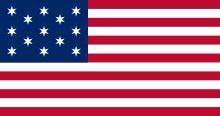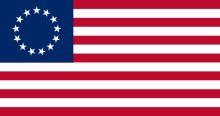Every school kid in America knows this one. Was it…..
Take Our Poll1. Betsy Ross is widely credited with designing the first American flag, but there is almost no evidence to support that claim. The only records of Ross’ involvement came from her own grandson in 1870, when he presented the Historical Society of Pennsylvania in Philadelphia with affidavits from his own family members as evidence. Instead, many historians believe that Francis Hopkinson deserves the credit, because early journals from the Continental Congress are said to explicitly name him as the flag’s designer.
( OK folks don’t shoot the messenger. I have no idea how and why we all believe it was Betsy Ross all these years. I just bring you new info to make you go )

Hmmm
The Flag Resolution of 1777[edit]
On June 14, 1777, the Second Continental Congress passed the Flag Resolution which stated: “Resolved, That the flag of the thirteen United States be thirteen stripes, alternate red and white; that the union be thirteen stars, white in a blue field, representing a new constellation.”[9] Flag Day is now observed on June 14 of each year. While scholars still argue about this, tradition holds that the new flag was first hoisted in June 1777 by the Continental Army at the Middlebrook encampment.[10]

Francis Hopkinson’s design for a U.S. flag, featuring six-pointed stars arranged in rows.

13-star “Betsy Ross” variant
The first official U.S. flag flown during battle was on August 3, 1777 at Fort Schuyler (Fort Stanwix) during the Siege of Fort Stanwix.
Massachusetts reinforcements brought news of the adoption by Congress of the official flag to Fort Schuyler. Soldiers cut up their shirts to make the white stripes; scarlet material to form the red was secured from red flannel petticoats of officers’ wives, while material for the blue union was secured from Capt. Abraham Swartwout’s blue cloth coat.
A voucher is extant that Capt. Swartwout of Dutchess County was paid by Congress for his coat for the flag.[11]
The 1777 resolution was most probably meant to define a naval ensign. In the late 18th century, the notion of national flag did not yet exist, or was only nascent. The flag resolution appears between other resolutions from the Marine Committee. On May 10, 1779, Secretary of the Board of War Richard Peters expressed concern “it is not yet settled what is the Standard of the United States.”[12]
The Flag Resolution did not specify any particular arrangement, number of points, nor orientation for the stars and the arrangement and appearance was up to the maker of the flag. Some flag makers arranged the stars into one big star, in a circle or in rows and some replaced a state’s star with its initial.[13] One famous arrangement features 13 outwardly-oriented five-pointed stars arranged in a circle, the so-called Betsy Ross flag.
Although the Betsy Ross legend is controversial, the design is among the earliest 13-star flags. Popular designs at the time were varied and most were individually crafted rather than mass-produced. Examples of 13-star arrangements can be found on other flags attributed to Francis Hopkinson, the Cowpens flag, and the Brandywine flag.
Despite the 1777 resolution, a number of flags only loosely based on the prescribed design were used in the early years of American independence. One example may have been the Guilford Court House Flag, traditionally believed to have been carried by the American troops at the Battle of Guilford Court House in 1781. Other evidence suggests it dates only to the nineteenth century.[14] The original flag is at the North Carolina Historical Museum.
The origin of the stars and stripes design is inadequately documented. The apocryphal story credits Betsy Ross for sewing the first flag from a pencil sketch handed to her by George Washington. No evidence for this exists; indeed, nearly a century had passed before Ross’ grandson, William Canby, first publicly suggested it.[15]
Another woman, Rebecca Young, has also been credited as having made the first flag by later generations of her family. Young’s daughter was Mary Pickersgill, who made the Star Spangled Banner Flag.[16][17] According to rumor, the Washington family coat of arms, shown in a 15th-century window of Selby Abbey, was the origin of the stars and stripes.[18]
Francis Hopkinson of New Jersey, a signer of the Declaration of Independence, designed the 1777 flag[19] while he was the Chairman of the Continental Navy Board’s Middle Department, sometime between his appointment to that position in November 1776 and the time that the flag resolution was adopted in June 1777. Hopkinson was the only person to have made such a claim during his own lifetime, when he sent a bill to Congress for his work. He asked for a “Quarter Cask of the Public Wine” as payment initially.
( The poor guy asks for a jug of wine, Cheap public wine at that, and is refused. sheesh what a bunch of cheapskate’s. )
The payment was not made, however, because it was determined he had already received a salary as a member of Congress.[20] This contradicts the legend of the Betsy Ross flag, which suggests that she sewed the first Stars and Stripes flag by request of the government in the Spring of 1776.[21][22]
http://en.wikipedia.org/wiki/Flag_of_the_United_States
~Steve~ I’m out of here.

Bye-Bye

